Using the Internet
| [ LiB ] |
Using the Internet
"Whoever has their art on the most people's hard drives when he dies, wins."
Me
The Internet is the best way to cheaply promote your music worldwide. But keep in mind that everyone else is doing it, too. Here's how to do it, how to stand out, and how to make, not lose, money in the process. Do your own promotion and distribution online, without spamming .
A Web site should at least be a brochure. I hate sites that beep and flash and spin and do a whole bunch of crazy crap, but I can't even find the contact info quickly! Also, you don't want to make people jump through a bunch of hoops to get to your stuff. It takes long enough to download a song; I don't wanna have to look at Pepsi and Britney Spears ads to get to your music, ya know?
You can sell your art directly from your site by adding a PayPal button for payment (paypal.com). They don't take much money out on each sale and will put the rest directly in your bank account. I used to sell stuff on amazon.com, but they take almost half the retail price (although they do fulfill the orders) plus they have started charging on top of that! (My books are still on there, but my publisher pays the fees, not me.)
If you're personally responsible for fulfilling (shipping) product when people order it, do it in a timely manner. You should be honored when anyone spends hard-earned cake on your art. Get it out there quickly.
Cdbaby.com gets your CDs on www.towerrecords.com (complete with streaming two-minute MP3s). Cdstreet.com is another one some of my friends use.
I also put my stuff on eBay. And you not only can sell your regular new CDs of your band on there, you can sell your personal memorabilia. Gwar sells props from old tours . I've sold the rough drafts of my books with handwritten margin notes (after the books come out, of course). It's all good.
You should also spend a good bit of time scanning and linking all the press you get. And share the same with your e-mail list. Keep people up on what you're doing. You probably don't have to send out an e-mail for every little thing you do, but I let people keep track. When I got interviewed on NPR, you can be sure I let my peeps know so they could tune in.
Also, periodically check any links to stuff linked from your Web site to make sure the page hasn't disappeared or the info on it hasn't moved.
NOTE
A lot of what I know about the care and feeding of computers and dealing with the Internet and such is already covered in my book $30 Film School . If I repeated it all here, this book would be about a thousand pages long. So I would recommend reading that book, too, even if you never plan to make videos, although I'd say any musician who doesn't plan to make videos , in this day and age, is insane, or at least denying her art a huge whole 'nother dimension. Mark my words: DVDs, in some form, will replace CDs as the thing you buy when you buy a band's latest release. If you can't afford both books, do what I do: Sometimes I go sit in a chain bookstore and read it without paying.
Figure 13.14. Mini-DV video cameras .
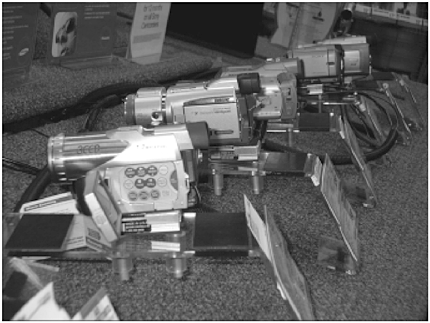
You might want to get a digital still camera to take photos for your Web site or for CD and DVD covers, or importing as stills in videos. (I love this look, by the wayI do it with the drum drill photo in the credits of "Left My Band in San Francisco.") They are cheap and good. I took most of the photos in this book myself with a Toshiba PDR-332. It was $210 from www.refurbdepot.com.
Figure 13.15. Digital cameras.
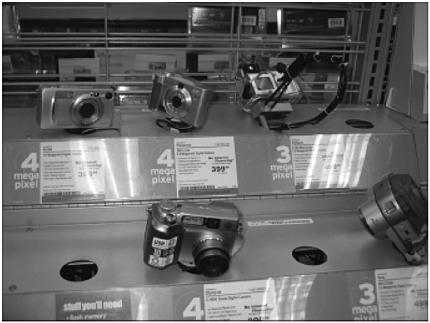
There are more of these right now, on eBay, complete with guarantee. So look around.
It's 3.2 megapixel, and I spent 60 bucks extra for a 128-meg memory card so I can take 200 high-rez photos, or 1200 Web-rez ones. It's very easy to use.
I love it. I got it to take the photos for this book, but I'm having a blast learning to use it. I guess that's because I'm making art (even though I'm not trying toI'm just trying to learn to use the camera). It's been a while; I've been so busy teaching art this past year (writing these books, touring to do seminars , speaking at schools , squats, bars, and museums) that my big ole art heart has gotten a little cranky from lack of use.
I'm not going to teach you Web design here. Everyone pretty much knows how to do that already. If you don't know, get your 12-year-old sister to teach you.
I will tell you what programs I use. I do my basic Web design and uploading in Dreamweaver and use Photoshop to manipulate images.
I will cover some basic important concepts that aren't so much second nature, and show a few music-specific programs and techniques that will aid your desire to be heard .
MP3s
MP3s are 1/10 the file size of uncompressed audio files and sound almost as good. They are the format of choice for sharing music across the Internet.
You'll want to upload a few MP3s of your songs to the Internet so people can download them.
You can create MP3s with a freestanding utility like AudioCatalyst (shareware from www.xingtech.com). Also, many other programs, like Sound Forge, allow you to use a drop-down menu to choose to save as MP3 format.
Figure 13.16. AudioCatalyst.
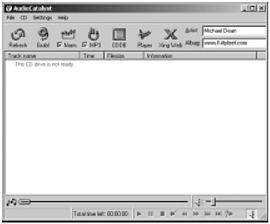
Figure 13.17. Sound Forge drop-down menu for Save as File Type.
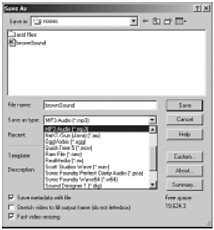
NOTE
If there are things you can set for different criteria in your MP3s, 128K Joint Stereo is generally the accepted standard. Most programs do this as a matter of default, but if they don't and you have to set it manually, set it to 128K.
Make sure to tag your MP3s with meta information. This can be done with just artist and song title info in AudioCatalyst as you make the MP3. Type it in the spaces in the top right corner. Or do it later in more detail with a stand-alone utility, such as Easy Tagger (shareware from www.istoksoft.com). I've included a working demo on the CD. This will make it so your band name , album, and URL appear on the MP3 player (software or hardware) when your song is played . MP3s tend to get e-mailed, re-linked, and shared with programs like Kazaa, and you want people to be able to contact you or at least know what they are listening to if they didn't get it from your site.
Figure 13.18. Easy Tagger.
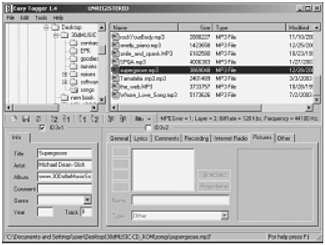
To use Easy Tagger, just open it, ignore the nag screenthe demands to pay and registeryou're just trying it out, remember? You can pay later if you like it. Open the program. Dig the cool translucent look pretty damn psychodelic if 'n you ask me. Hit the little tic mark next to 1D3v1 on the next screen, and enter your info like I did here. Then hit the little Save icon (the thing that looks like a floppy disc above and just to the left of the 1D3v1 tic box), and you're set.
Then it will scroll the information somewhere in any MP3 player to show the listener the song title, name, artist, and album.
Figure 13.19. Tagged song displaying info as it plays in WMP.
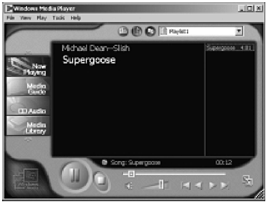
With stuff that isn't from an album (or sometimes even if it is), I put my URL. That's more important than the album name, in my book. My Web sites are my window onto the World and often the World's first point of contact with me.
You can also set the song style (punk, jazz, choral, classic rock, and so forth) from a drop-down list if you want. This is kind of against my gut feeling. I hate to categorize my art, and the fact that I am not willing to do this is one reason I have to operate outside "the biz," but doing so will make it easier for the listener to organize their favorites in some MP3 players. It's your call.
NOTE
When you install programs, if your firewall asks permission for the program to access the Internet, mark the tic box Remember This Answer Next Time I Use This Program and hit No, unless it has a reason or need to access the Internet. Otherwise, you're giving "them" access to info they have no right to be accessing. Be especially wary of programs that ask to "act as a server."
The exception, of course, is programs like browsers, FTP utilities, etc, that by definition need to access the Internet, i.e. it is their job to access the Internet.
And note that Kazaa and other file-sharing utilities are servers, so they will need permission to act like a server, damn it.
Figure 13.20. Firewall asking for permission to access the Internet.

I was one of the first people to use MP3s on the Internet (in 1996), and I was one of the first users of MP3.com. I used to love this service, but now they limit the number of MP3s you can upload free, charge for more, and bombard you with ads and demand your sales profiles with every download. Ain't these folks ever heard of cookies? It seems like a doomed business plan to me.
www.besonic.com is a site I like. And Zebox.com is good, too (and I don't just say that because I've been their featured artist three times). They don't have as many ads, don't charge you, there's no limit on number of songs, no demand for demographic info with each download, and they are not (yet) owned by Vivendi.
I try to put at least one MP3 somewhere with a direct URL so people don't have to jump through hoops to get it.
Like this:
http://www.kittyfeet.com/pj.mp3
Bandwidth ain't that expensive any more. Just put stuff on your own site.
I avoid Geocities and places that don't allow use of direct URL downloads and that add banner ads and crap like that. Server space is cheap or free.
I have a friend who says, "One thing I do is when I do Web design for people, I host MP3 files on their extra server space, then link from my site. They never know."
Photoshop Web Gallery
A really good way to put a bunch of photos up on your Web site without a lot of work is the one-click utility in Photoshop 6 or later called Web Photo Gallery.
Figure 13.21. Make Web Photo Gallery in Photoshop.

This brings up a dialog box to set the style and font, as well as to choose the folder to be processed and the destination folder.
Figure 13.22. Setting style, input, and destination folders.
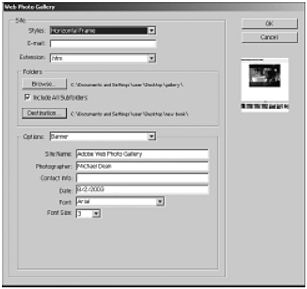
This instantly generates a set of Web pages (which you can later alter in your Web design program if you want) that look pretty damn good. It includes automatically generated clickable thumbnails so people can see what they're gonna get before they bother to click on something.
Note that this process also resizes your actual images and makes them smaller. But still, it's a nice way to share a bunch of photos (like all the photos from a given show) quickly and without a lot of work.
Figure 13.23 shows what the result looks like.
Figure 13.23. Automatically generated Web page.
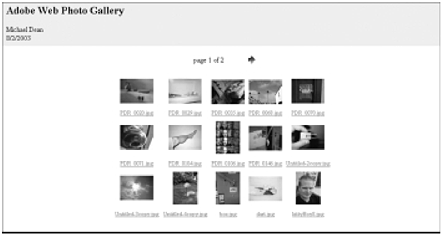
When you're done, just upload the entire new folder and link the index page elsewhere on your site.
See the final result at www.kittyfeet.com/gallery.
The actual file path of this is www.kittyfeet.com/gallery/index.htma Web site automatically opens index.htm or index.html in a given folder by default if none is specified.
NOTE
You can also batch process large print-rez images to Web-rez size automatically in Photoshop. It's kind of tricky and outside the scope of this book. But it's in the Help menu of Photoshop. Just search using the Batch command in the Help menu.
NOTE
Why I Love the Internet
When I was a kid I felt really isolated and not accepted by other kids . The thing that saved me was making a little micropower FM radio transmitter. It had two transistors , three capacitors, a diode, and a battery. I built it into the handset of an old telephone. I would go into the woods behind our house and hike and talk. I felt almost like I had a direct line to God. I would ramble in typical, yet advanced, little-boy poetry and smash my psyche into the sky. I would write my mile-high invisible graffiti skywriting that could only be known to anyone with an FM radio within a quarter-mile.
At first, I made sure to only transmit when far enough into the woods that there was a great chance no one was listening. After a bit, I got more adventurous and brought my weird science to school. Some of the kids teased me aloud for "talking to himself on that stupid broken phone," 'til one day, someone had snuck in a little radio (the principal hated rock n' roll and had tacitly banned radios, but broken phones were okay) and happened to be tuned into that frequency. They found out I was actually broadcasting.
It didn't even matter before that no one was listening. It was the possibility that someone might be listening that made it more interesting than just reading or watching TV. I was not just passively consuming ; I was doing.
As a kid I was also really into sending away for thingsfree samples, record clubs, writing letters to the editor (and fan letters to artists and scientists I admired). I felt really trapped in my little town and felt that anything I could do to get my mind to extend out into the world was more powerful than sitting around accepting the stuff that the TV spoon fed me.
This is the reason that when I first discovered punk rock firsthand (at age 18, in 1982) and got on the Internet (in 1996), I was totally taken by both of them. Punk seemed powerful because it was all about doing it yourself and not waiting for permission from anyone to do it. The Internet seemed the same but more so, it was like, "Wow, I can publish my own stuff and anyone in the world can read it."
I was hooked.
I spend at least eight hours a day now on a computer. Granted, I'm not looking at the Internet all that time, but I do have a high-speed connection open all that time and do stuff on the Internet often. But it's rarely surfing the Web (unless I'm looking for specific information). It's more likely making the Web. I am less into consuming media and more into being the media.
I hope you are, too. If you're reading this book, chances are that you are. It's the $30 Way.
AddWeb
AddWeb (shareware from www.cyberspacehq.com) is a great utility for adding your site to a number of search engines at once. You simply type in the URL, site name, a description, and your meta words (the words you've included in the HTML head that are seen by the search engine but not the Web surferunless they click View/Source).
The full version submits to about a thousand engines, but the free version submits to the 12 engines that most people use anyway. So that's almost as good. Buy the other version if you want; it's best to cover all your bases when you can.
I use the wizard and allow it to Populate from Web page; that way you don't have to type all the meta info in yourself. But to do so, you first have to upload the Web page. This is obviously one of those programs you are going to want to allow your firewall to access the Internet with. Otherwise, it won't work!
Figure 13.24. AddWeb.
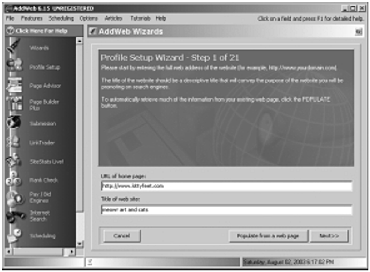
By way of explanation, here's the meta tags in the HTML head that I added by hand when I did the coding for a music page on my site. (The site is all my music. I bootleg myself.)
<html><head><title>Free bootleg rock! MP3s! Yes! Fuck yes!</title><meta name="description" content="THE BEST FREE MUSIC ON THE NET. MP3s FROM HELL!"> <meta name="keywords" content="art, free, rock, Bomb, mp3, mpeg, michael dean, punk, love, los angeles, San Francisco, mp3, computer, warez, counter culture, quicktime, on line, Rock, n', Roll, kittyfeet, Anarchy, meow, movies, food, coffee, fun, joy, pleasure, lust for life, grrrl, grrl, grrrrl, poetry, literature, alternative"> </head><body background="blue.jpg" TEXT="#00FFFF" BGCOLOR="#0000FF" vlink="#FFFF00" LINK="#FFFFFF"></head>
NOTE
It's best not to put unrelated keywords in your meta tags. It may seem cool, like it will bring more people to your site. And it will, but it defeats the usefulness of the Web, and you'll end up pissing off a lot of people, and it will work against you. You'll also get way more spam (some spam companies make lists of e-mail addresses harvested off of sites based on keywords). Some search engines will actually remove you if they figure out you're doing this.
emailSTRIPPER
emailSTRIPPER is a very cool tiny freeware program from www.papercut.biz/emailStripper.htm . It's included on the CD with this book. It removes all that junk formatting that you get from cutting and pasting from e- mails sent from one person to another. Removes all the extraneous >>>>>> as well as other symbols and junk carriage returns.
Figure 13.25. emailSTRIPPER.
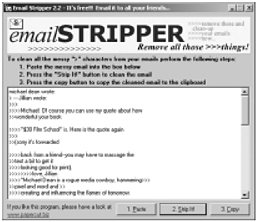
Here's some forwarded e-mail text:
michael dean wrote:>- Jillian wrote:>>>>>>>Michael: Of course you can use my quote about how>>wonderful your book>>>>"$30 Film School" is. Here is the quote again>>>>>(sorry it's forwarded>>>>back from a friendyou may have to massage the>>text a bit to get it>>>>looking good for print).>>>>>>>>love, Jillian>>>>>>>>>>>>>>>>>>>>>>>>>>>>>>>>>>>>>>>"Michael Dean is a rogue media cowboy, hammering>>>>>pixel and word and >>>>>>creating and influencing the flames of tomorrow.>>>>>He sits in his room>>>>>>rocking away on his computer harder than Tony>>>>>Iommi does his guitar.>>>>>>While you're out getting drunk and bragging about>>>>>how you're gonna be>>>>>>somebody someday, he's quietly DOING it.>>>>>>>>"Michael's film book and his D.I.Y. movie changed my>>>>>life. I quit my job>>>>>>because of them and now have the courage to make>>>>>art full time.>>>>>>Michael, I really want to meet you! If you ever>>>>>come to Seattle, you >>>>>>have a place to stay and unlimited back rubs (and>>>>>more).">>>>>>Jillian Bronly,>>>>Seattle, WA> __________________________________> Do you Yahoo!?> Yahoo! SiteBuilder - Free, easy-to-use Website design software> http://sitebuilder.yahoo.com
Here's the same after stripping it with emailSTRIPPER:
Michael: Of course you can use my quote about how wonderful your book "$30 Film School"is. Here is the quote again (sorry it's forwarded back from a friendyou may have tomassage the text a bit to get it looking good for print).love, Jillian"Michael Dean is a rogue media cowboy, hammering pixel and word and creating andinfluencing the flames of tomorrow. He sits in his room rocking away on his computerharder than Tony Iommi does his guitar. While you're out getting drunk and bragging abouthow you're gonna be somebody someday, he's quietly DOING it."Michael's film book and his D.I.Y. movie changed my life. I quit my job because of themand now have the courage to make art full time. Michael, I really want to meet you! Ifyou ever come to Seattle, you have a place to stay and unlimited back rubs (and more)."Jillian Bronly, Seattle, WA=
Make sure you delete the line it adds at the bottom:
"This email was cleaned by emailStripper, available for free from http://www.papercut.biz/emailStripper.htm."
NOTE
When you put a URL (Web address or e-mail address) in any outgoing communication (e-mail, Web site, flyer, or press release), always test it first! Little is worse than sending out press kits (e-mail or printed) with a non-working URL in them. I always type it into the title bar of an active browser, make sure the page loads, and then cut and paste from the title bar.
Linking
I have heard of people getting upset about being linked, but I think they are insane. If they don't want to be linked, they shouldn't be on the Internet. I think links are always okay, and I don't ever ask permission. The nature of the Web is such that it invites linking. It is based on linking.
If you want to cover your ass, just don't link anyone in a way that implies a partnership or endorsement that does not exist. For instance, if you have a page on your site that says "We like Gretsch guitars," with a link, then you're probably cool. If you say "Joe Blow and the Nobodies use Gretsch Guitars exclusively" and have a link with their corporate logo, it kind of looks like they have signed you to an endorsement, which is misleading.
The only linking that upsets me is leeching, which is where people link a file on their site without linking the page, like putting one of my songs for download on their site, or especially an image. It's basically using my art (and bandwidth!) as theirs without credit.
Some guy named Kevin leeched images from my site, the photos of people in "D.I.Y. or Die," and gave them dumb names and captions on his site. But he still was serving them from my site. (I discovered this from my Web logs.) I changed the filenames and HTML on my end and made new image files with the old file names (so they would show up on his site) My new image files said "Kevin is a leech and a thief ." They stayed up on his site for two weeks with people viewing them every day them before he noticed and took the page down!
NOTE
I always use the HTML command open in new browser target=_Blank "easily done with right-clicking make link command in Dreamweaverso people don't leave my site when they look at an external page.
Web Boards and Mailing List Services
You will probably want to have a Web board so people can post things. You will need to weekly (or in my case, daily) maintain it and delete stuff: You'll probably get some board spam, commercial posts unrelated to your cause, and people saying mean things. (The more I get recognized for my art in the public eye, the more I find less-celebrated former "friends" coming out to talk smack about me.)
I usually leave mean stuff up if it's ridiculous enough to be funny and if the person signs it. If they're a jerk and don't sign it, I delete it. And I always delete unrelated "get rich quick" crap.
Yahoo Groups (http://groups.yahoo.com) is good, but they put ads on every page. You can get one that you serve on your own site called wwwboard free from www.scriptarchive.com. This is the one I used on my site. But it involves a tiny bit of scripting that almost borders on programming. If you are not computer intuitive, I suggest going with the Yahoo! solution. One advantage of Yahoo! is that you will be able to be searched by people on Yahoo! by keywords easier.
I put this disclaimer on my Web board:
"And anything posted here becomes property of Michael Dean and may be used in any way he sees fit. And he thanks you."
That way people know that I might use it later elsewhere as advertising or whatever if I like it.
Topica.com
Topica is a very good way to maintain and administer your mailing list. People sign up by sending an e-mail; it's automatic. I put this line as my sig line (signature) at the bottom of all my e-mails, and I have it on a few places on my Web site:
If you want on my mailing list send an email to kittyfeet69- subscribe@topica.com
You can block people later and remove them from your list if you need to or just turn their receiving of e-mails on for a particular mailing, then turn it back off. They can unsubscribe themselves without bugging you. Topica does not sell or trade or abuse your list. You can search and export your database, and it is secure, and they don't trade e-mails. They do put an ad at the top and bottom of each mailing, but I get around it by putting:
(Ignore the ad above. Topica puts it there) at the top of every outgoing message and
(Ignore the ad below. Topica puts it there) at the bottom.
For some reason, Topica won't display e-mail addresses in a mass e-mail; it's probably an anti-spam legality thing. So when I have to send an e-mail with an e-mail address somewhere in it, I do a workaround of just linking an HTML page with the URL displayed, or the URL of an image file with the address. (I heard they may be fixing this, so run a test.)
Using an image file for an e-mail URL on a Web site is good also to prevent spam. An image (unlike text or HTML) cannot be scanned by a roving mail-gathering bot. People actually have to type the e-mail address rather than just click to e-mail you, but if they really want to talk to you, they'll take the five seconds to do that.
NOTE
Send out stuff about your friends and people you don't know on your e-mail list. If it's all you, it's kinda piggy . But if you toot other people's horns, too, you're just being a cheerleader for art: yours and everyone else's.
Testimonials
Get people, especially famous people, to write blurbs for your books, Web sites, records, all your art. I do. It helps. Also, when you get a fan letter or e-mail, ask the person to post a review on your Web board and on Amazon.com if you're selling your stuff there.
I always did this and sort of felt like a loser for it sometimes, like "No one who really has their shit together would do this," until I wrote a fan letter to Lloyd Kaufman of Troma films and he asked me to post a review on Amazon! That dude is totally famous and rich and successful and makes cool art on his own terms.
Don't ever post the contents of someone's e-mail on the Web without permission. One time I told a guy I really liked his music and was a little dismayed to find my letter reprinted on his Web site. E-mails are personal one-to-one communiqu s and should not be shared unless you ask. Most people (including me) would say "sure" if asked in that situation, too.
Promotional Zest and Artistic Zeal
In order to really get yourself out there, you have to:
Have great stuff
and
Have a religious fervor for your own output.
Remember the movie The Blues Brothers ? A recurrent line in that film was the leaders of the band saying (and believing), "We're on a mission from God."
I sort of believe that about myself and my art. I mustI have worked for over 20 years making about 50 cents an hour doing art. (This year was the first time I've actually made enough money to be above the poverty line, and that includes the year and a half that I was on Warner Brothers.)
I just believe that what I do is important enough to give up security and creature comforts to work on. I am very intelligent (my I.Q. is 143genius on some scales and almost genius on others), and I could have had all-expenses-paid scholarships to any college I wanted when I was younger . Instead, I dropped out of high school (got kicked out, actually) and went to live on the streets in Washington, D.C., at age 19 and played in a punk rock band.
That set the pace for my life. I definitely could have been a lawyer, doctor, or scientist making over $100,000 a year. (I could be making twice that if I'd gone into marketing. I'm very good at it. Except that I get suicidal when I'm trying to market something I don't believe in.)
Instead I've devoted my life to making art in every medium I can, and I've averaged under ten grand a year my whole life. And I love my life!
To really get the world to believe what you believe, you first have to really believe it yourself. And I don't mean being pumped up with ego and convincing yourself that you're great, even if you suck. (Think everyone on American Idol or Live at the Apollo , but especially the losers.)
I guess what I'm getting at is if you're great, if you have that indefinable spark that makes people stand out from the crowd , if you are truly talented and original (if not outright visionary !), you still have to be driven and relentless to get the world to notice. And this is true from the most integrity-filled indie punk rock icon to the person in the number one spot on the charts . They both believe in themselves to the point where they do not even question when someone questions them they just sidestep it and move on. They trust their vision, drive, and internal mission statement with an unfaltering accuracy.
I've taken a lot of heat for being like this. A lot of people hate me because I toot my own horn. But I figure that if I don't toot my own horn, no one else will.
(As I was just sitting in the Dallas airport typing this, Tiffany called to tell me that there's a huge article about my upcoming Houston B. Dalton bookstore book signing in the weekly entertainment paper there. It kinda proved my point and made my day.)
Figure 13.26. My sweet, smart, talented helluva cool friend, Tiffany Couser.

Anyway, you have to believe in your art to get it out to the Universe.
NOTE
I don't mind if I only sell a few of a piece of art. I don't look at it as "moving units." Major labels do. They would just as soon sell soap as art if it paid as well.
I'm like Johnny Appleseed. Each sale is not just a unit shipped, it is the potential to change a life.
So, how do you do this without stepping on people's toes and without being a violently self-serving egomaniac? Easy. Other than living a virtuous life (and my idea of virtue is probably far more decadent than most people who use that term ), you give up your part in it. You make it about the art , not about the artist . Sure, you put your name alongside the art, sign it, get to go along for the ride, and cash the checks at the end of the day, but it ain't about you.
It's about the art. You're bragging for the art. Not yourself. The art is the star, not you.
This little shift in attitudinal behavior allows one to be a hellfire and brimstone pulpit pounder for the cause of good without being too much of a brat. It's about the art. Period.
I go through an airport and I see blank food tubes selling out to the corporate ideal. Yuck, man, it's shallow . And it's totally the Peter Principle. Today in first class (I fly all the time, but today was the first time I've ever flown in first class on a standby ticket donated by an airline employee who believes in my art), the goon sitting next to me was some well-paid, doughy, white, middle-aged, middle management type. I put on my eye shades and tried to sleep, but I nosed my peepers out the edge of the shades to see what he was writing. He was writing an evaluation of the 120 employees below him, and in about 20 words each, deciding their fatewho should get promoted and who should get fired . And this guy's English skills were about equivalent to an eighth gradertypos everywhere!
He probably has a secretary to edit his crap and make him look good. Hope he doesn't have her fired, too.
Getting Your Stuff into Stores
Many local stores will take stuff on consignment . This means no money up front, and you get some later if and when they sell.
This is covered in detail in $30 Film School , but basically it works like this: You approach local merchants and nicely ask them to take a few units on consignment. You sign a little form. You go out and hang flyers. You go promote. Then you go back in 90 days and nicely ask them if they sold your art and get some money if they did.
As far as getting your stuff distributed in chain stores and stuff like that, it's very difficult. I tried with my records and books that were on independent labels. The result was spotty coverage at best. The one record I did on Warner Brothers got into every store in America (only one copy in some cases, but at least it was there). These books, the $ 30 School series, get into Borders, B. Dalton, and Barnes & Noble, everywhere. I tried hard to get that done myself with my self-published novel to no avail. Like I said, people can get the job done when their job is getting their job done. But it's rare that people are as smart as my publisher and put out something good like this. More often, you have a better chance of selling another damn cat book than successfully pitching something that will actually help people. I love cats but hate cat books. They are very nearly the lowest common denominator of the publishing industry.
I think the best win-win situation is somewhere between being totally independent and being on a major. I like to make what I love for myself and then find a distributor. I did this with my D.I.Y. or DIE movie.
This methodology gives you the most control and the most money, too.
Here are a few of the bigger independent distributors : Mordam Records, Red Distribution, Alternative Distro Alliance (ADA), Choke Distribution, Very Distro, Midheaven Mailorder, Interpunk and Dischord. They are all very easy to find online. Most of them take CDs and DVDs. Some of them are very picky about what they take, not just musically, but ideologically.
For DVD-only distro (distribution), try Facets Multimedia, Music Video Distributors (MVD); and for Europe, Quantum Leap.
For any of them, you'll have to send a sample, a polite, short cover letter, and a press kit. Then wait six weeks and follow up with a polite phone call.
In music you will usually go through as many as you can. With film, sometimes they will give you an advance and want an exclusive. I did that with MVD with the D.I.Y. or DIE DVD. Sometimes the film rules work with music, sometimes vice versa. Feel it out.
Just make what you can, make it great, and get it out there.
NOTE
Big chain stores like Tower usually won't take home-burned CDs. Because home-burns will play on most, but not all CD players, these places have a policy of not taking them. They don't want to deal with the returned copies. To get into these stores, you have to have a manufactured CD. Something about having them pressed from a glass master, rather than burned on a computer, ups the playability rate past 99.9 percent, so stores don't have to deal with returns.
Endcap
Endcap is a retail sales term (equally at home in the cheese section of Whole Foods as it is in Tower Records or Borders Books or a tiny, spunky indie punk store) for those little displays of select product that stores have at the end of aisles . It's the first thing the consumer sees when she walks into the store or section. The record company/publisher/cheese manufacturer pays the store to put them up there. It's basically advertising.
You can pay independent promoters to do the same for you, but it's not gonna work as well as it will for the big boys. You're better off putting your money into other thingscheap ads in magazines your people actually read, going on tour, and sending out promo copies to radio stations .
Some independent promoters are a total scamit's old fashioned illegal payola under a new legal name. Big labels hire them and basically pay stations through them. The coolest indie artists don't hire them, so why bother?
Here's the Web address of an article explaining this in detail: www.stereo-phile.com/shownews.cgi?1623.
| [ LiB ] |
EAN: 2147483647
Pages: 138
- Penultimate Hop Popping
- Command Reference
- Configuring L2TPv3 Static Tunnels
- Implementing AToM for Like to Like Circuits
- Case Study 2: Implementing Multi-VRF CE, VRF Selection Using Source IP Address, VRF Selection Using Policy-Based Routing, NAT and HSRP Support in MPLS VPN, and Multicast VPN Support over Multi-VRF CE